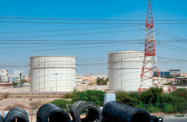While cement manufacturers in Oman are expanding operations to meet new domestic and international demand, they continue to face a challenging business environment due to intense foreign competition. However, the outlook for future growth remains positive as the government rolls out infrastructure projects as part of its current five-year economic development plan.
In July, Oman Cement Company (OCC), the second-largest cement manufacturer in the Sultanate, announced plans to set up a ready-mix concrete plant. A new 150-tonnes-per-hour cement grinding mill is also to be installed, for which the company is in the final stages of identifying a vendor. OCC, which was established in 1978 and is majority owned by the state, has an annual clinker capacity of 2.4m tonnes.
The news came on the back of promising growth over the past 18 months. In 2012 the company recorded a 36.7% rise in net profit, reaching $45.5m from $33.2m in 2011. Revenue increased by 17% to $154m in 2012, up from $131.7m in 2011. In the first six months of 2013, OCC earned $24.1m in net profit, a 3% increase from the $23.4m it achieved in the first half of 2012.
However, sales and output are both down slightly in 2013. Between January and June, revenue fell to $71m, from $72.9m for the same period in 2012, with production dropping by 5.23% to 1.06m tonnes. This was in part due to technical problems at one of the company’s four cement mills, which was shut for repairs for about a month beginning in mid-June.
Meanwhile, Raysut Cement Company, the largest cement producer in Oman, announced in July that it saw a 19.6% increase in net profits for the first half of 2013, earning $42.6m, up from $35.6m in the same period last year. However, sales revenues remained flat at $128.6m, compared to $128.7m for the first half of 2012. Cement output decreased 4%, dropping to 1.96m tonnes, as against 2.03m tonnes in 2012, while clinker production fell by 5% to 1.68m tonnes from 1.76m tonnes. The rise in profits was in part due to a decline in manufacturing and overhead costs, while investment income increased.
Foreign competition remains a challenge for local producers. In 2012 Raysut predicted that the construction industry in Oman would grow to $5bn by 2016, at an average rate of 6% per year, but added that cement suppliers faced “significant” pressure from imports from UAE, which has an estimated overcapacity of 65%, according to trade publication Global Cement.
Raysut chairman Ahmed Al Ibrahim said the company’s international operations have helped mitigate the effects of foreign competition.
“The company’s strategy has been to expand its market base through supplies to Yemen, East Africa and other countries. The company has met with challenges effectively by holding on to sales and enlarging the profit of the group as a whole by optimising sales in varied markets,” Al Ibrahim stated in his chairman’s report on the first-half-year results for 2013.
He added that the construction sector across the GCC is expected to grow by 19% in 2013, fuelled by government initiatives. This includes projects in Oman, where he noted that the construction industry is projected to expand by 5.5% this year.
According to the Sultanate’s current five-year economic plan, running from 2011 to 2015, the government intends to invest $10.7bn, nearly 10% of the total budget, in the construction of transport infrastructure and other projects, including $6.2bn for airports and $3.2bn on roads. An additional $1.3bn has been allocated to the water supply and dam construction.
Investments in infrastructure – both locally and abroad – should help support growth at the Sultanate’s cement makers. While they face stiff competition from foreign manufacturers, both OCC and Raysut have demonstrated an ability to increase profits in a challenging market.

